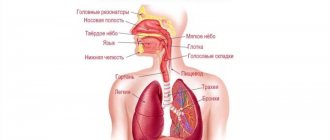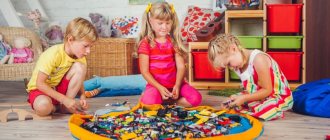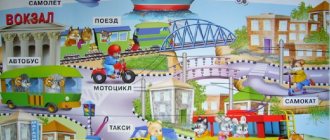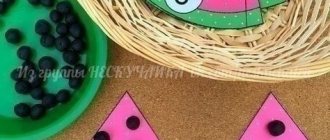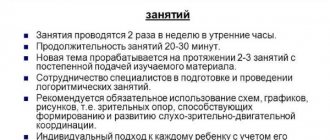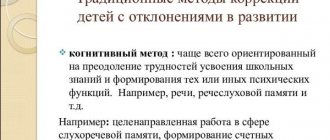LiveInternetLiveInternet
Quote from Kseneia's message
Read in full In your quotation book or community!
Games for developing correct sound pronunciation in children with dyslalia"
Anya, I have only such games for my card index so far, I’ll look at them again, then I’ll add them
“Games for developing correct sound pronunciation in children with dyslalia”
Selection of methodological material for working with children with dyslalia:
GAMES FOR FORMING CORRECT SOUND PRONUNCIATION
1) FORMATION OF HISSING SOUNDS Ш, Ж, Х, Ш
a) "Silence"
Target. Automation of sound w.
Description of the game. The driver stands at one wall, and all the other children stand at the opposite wall. Children should quietly, on tiptoe, approach the driver; with every careless movement, the driver makes a warning sound sh-sh-sh, and the sensational one must stop. Whoever quietly reaches the driver first becomes the driver himself.
b) "Train"
Target. Automation of the sound sh in syllables and words.
Description of the game. Children stand one after another, pretending to be a train. Ahead of the train is a steam locomotive (one of the children). The train departs on the command “Go-go, go-go, go-go.” The pace gradually accelerates. They drive up to the station (an appointed place or a building made of cubes) and say: “I came, I came, I came” (slowly: sh, sh, sh - let off steam). Then the bell is given, the whistle is blown, and the movement resumes.
Note. You can introduce semaphore and ticket sales into the game. You can complicate the game - children will depict different trains, for example, fast and freight. The ambulance moves to the sounds of shu-shu-shu - (fast), the freight one - shsshu-shshu (slowly).
c) “Bees and Cubs”
Target. Automation of sound g.
Description of the game. The playing children are divided into two groups: one group is bees, the other is bear cubs. Bees climb onto the gymnastic wall (or chairs). This is a beehive. The cubs are hiding behind a tree (bench). Hearing the signal “Bees, for honey!”, the children go down to the floor, run to the side and, like bees, fly from flower to flower. At this time, the cubs climb over the bench and walk on all fours to the hive. At the signal “The bears are coming, the bees return with the sound of zh-zh-zh. And the cubs quickly straighten up and run away.
When repeating the game, children change roles.
d) "Greedy cat"
Target. Differentiation of sounds sh-zh.
Description of the game. They choose a driver. He's a cat. The cat sits in the corner and says: “I’m a terribly greedy cat, I catch all the mice - and in my mouth.” The rest of the children are mice. They pass by the cat and whisper in fear: “Hush, hush, the cat is getting closer, closer.” Children say these words twice. With the last words, the cat jumps out and catches the mice. Anyone caught in the cat’s paws must say the words “quieter” and “closer” 5-10 times. Then the role of the cat is transferred to another child, and the game continues.
d) “Sparrows”
Target. Automation of the sound h in onomatopoeia.
Description of the game. Children (sparrows) sit on chairs (in nests) and sleep. In response to the teacher’s words, “Sparrows live in a nest and everyone gets up early in the morning,” the children open their eyes and sing loudly:
Tweet-chik-chik, chirp-chik-chik!
They sing so joyfully, The teacher finishes.
After these words, the children scatter around the room. To the words of the teacher, “We flew to the nest!” return to their places.
e) “Chizhik”
Target. Automation of the sound h and differentiation of sounds h-zh.
Description of the game. One child is a cat, the rest of the children are siskins. They occupy part of the site, which is surrounded by chalk. This is a cage. The other part of the site is free. The teacher (or selected child) says:
The little siskin was sitting in the cage, The little siskin in the cage sang loudly: “Chu-chu-chu, chu-chu-chu, I’ll fly away to freedom.”
After these words, the siskins wave their arms and fly to the free part of the site, uttering the words:
Chu-chu-chu, chu-chu-chu, I'll fly away to freedom.
The cat appears, and the siskins fly back into their cage. The cat catches siskins.
g) "Scouts"
Target. Automation of the sound in words and phrases.
Equipment. Brush, toy puppy, wood chip, box, raincoat, pliers.
Description of the game. The teacher sits the children in a semicircle and says that they will play “scouts”. Children are shown objects that will be hidden. They need to be found. For the search, a group of scouts is assigned who must find the object, bring it and name it. The one who found and named the item correctly receives a scout badge. (By analogy, a game can be organized to automate any sound.)
2) FORMATION OF WHISTLING SOUNDS S, S', Z, Z', C
a) "Pump"
Target. Sound automation p.
Description of the game. Children sit on chairs. The teacher tells them: “We are going to ride bicycles. You need to check if the tires are well inflated. While the bikes were standing, the tires were a little flat, we need to pump them up. Let’s take a pump and inflate the tire: “s-s-s...” Children stand up and take turns, and then all together inflate the tires, pronouncing the sound s and imitating the action of the pump. If a child fails to make a sound, it means that he is not performing the movements accurately. The pump is being repaired.
b) “Flowers and bees”
Target. Sound automation
Description of the game. Before the game starts, it is agreed who will be the bees and who will be the flowers (for example, boys are flowers and girls are bees). Then everyone scatters around the room or area. As soon as the teacher’s signal is heard (strumming a tambourine or clapping your hands), children pretending to be flowers take a knee. The bees flap their wings and fly from flower to flower, while they imitate the buzzing of bees: z-z-z-z. When the tambourine hits again, the children change roles, scatter around the playground, and the other bees practice pronouncing the sound z.
c) “Hares and Fox”
Target. Automation of sounds s—z in text.
Description of the game. According to the number of players, holes are drawn along the edges of the court or chairs are placed. Children (bunnies) stand at their holes. One of the players is a fox. The bunnies say the text: The gray bunny is jumping near the wet pines, It’s scary to fall into the paws of a little fox, It’s scary to fall into the little fox’s hands...
Bunnies run out of their holes and jump on both legs. Then they form a round dance and jump in a circle. The words of the teacher are heard:
Bunnies, prick up your ears, look left and right, is anyone coming?
The hares look around, seeing a fox that is slowly making its way towards them, shout: “Fox!” - and scatter into the minks. The fox catches hares. The game repeats itself.
D) “Vaska the Cat”
Target. Differentiation of sounds s, s', z, z', c in the text.
Description of the game. Children (mice) sit on chairs or a carpet, one child is a cat. He walks on his toes, looks first to the right, then to the left, and meows.
Teacher and children: Vaska walks white, Vaska has a gray tail, But he flies like an arrow, And he flies like an arrow.
The cat runs to a chair standing at the end of the room and sits on it and falls asleep.
Children: Eyes close - Are you sleeping or pretending? The cat's teeth are a sharp needle.
One mouse says that she will go and see if the cat is sleeping. After looking, she waves her hands, inviting other mice to join her. The mice run up to her, scratching the chair where the cat sleeps. Vaska the cat:
As soon as the mice scratch, Gray Vaska is right there. He will catch everyone!
The cat gets up and runs after the mice, they run away from him.
3) DIFFERENTIATION OF HISSING AND WHISTLING SOUNDS
a) “Bike ride”
Target. Differentiation of sounds s-sh.
Description of the game. The teacher says; “Now we will go for a bike ride. Let's check if the tires are well inflated. Weakly inflated, let's inflate them with a pump: ssss... (Children, imitating the pump, say: ssss...) The tires are well inflated, we only hear: the air hisses. It turned out that there was a small hole in the tire, and that’s where the air came out. How does air escape from a tire? (Children shhhh...) Let's seal the hole and inflate the tire again. (Children: ssss...)
Now you can ride bicycles. Who remembers how the air came out of the tire?” (Children: shhh...)!
You can draw the children's attention to the fact that when they inflated the tire and pronounced the sound s, the air was cold, the tongue was at the bottom. When the air came out of the tire (shhhh...), it was warm, the tongue was at the top.
b) “Cat and Mice”
Target. Differentiation of whistling and hissing sounds.
Equipment. Rope, two chairs, bench.
Description of the game. One of the players is a cat, and the rest of the children are mice. The mice are placed underground (behind a rope stretched between two chairs). The cat sits on a chair with his back to the mice. The presenter says:
On the bench by the window the cat lay down and dozed. Now the mice have plenty of freedom, They quickly came out of hiding, They all scattered into the corners, dragging crumbs here and there.
In response to the presenter’s words “quickly came out of hiding,” the mice crawl under the taut rope and run around the yard. The presenter says:
The cat opens its eyes, the cat arches its back. Spreads its claws. Jump - ran, scattered the mice!
The cat makes movements corresponding to the words of the presenter. At the words “jump - ran,” the cat jumps up from the chair and catches the mice, and the mice run underground (crawl under the rope).
c) “Little houses”
Target. Differentiation of whistling and hissing sounds.
Equipment. Animal masks.
Description of the game. A leader hare or a wolf is chosen for the game. The rest of the children are bunnies. They sit on chairs in a circle. The leader hare walks in a circle, knocking on the bunnies’ houses:
Small houses stand in the dense forest,
Little white bunnies are sitting in houses.
One bunny ran out, he ran through the forest,
He knocked on everyone’s little window with his little paw.
Come out, bunnies, let's go for a walk in the forest.
If the wolf appears, we will hide again. Then, being in the center of the circle, he beckons the children with his hands. The bunnies run out, jump, gallop until a wolf appears. When a wolf appears, the bunnies hide in their houses. The wolf catches hares. The one caught becomes a wolf and the game continues.
FORMATION OF THE SOUNDS R, R', L, L'
a) "Orchestra"
Target. Automation of sounds p, p' in syllables.
Description of the game. Children sit in a semicircle. One group of children are trumpeters, another are violinists, and the third are drummers. The teacher is the conductor. He shows each group how to imitate the movements of trumpeters, violinists and percussionists. Then he offers to sing some familiar tune. Trumpeters sing the syllable ru-ru-ru, violinists - ri-ri-ri, and drummers - ra-ra-ra. After the rehearsal, the teacher begins to conduct. Only the group to which the teacher points with a stick sings. When the teacher raises both hands, everyone plays at the same time. Then the teacher calls three or four children and invites them to perform some song on any instrument. The rest of the children are asked to guess what song was performed.
b) "Steamboat"
Target. Setting and automation of interdental sound l..
Equipment. To play you will need water (a basin indoors, a stream outdoors), toys; steamboat, small dolls, nesting dolls.
The teacher addresses the children: “We are going to go on a boat ride. Do you know how the steamboat hums? Listen: y-y-y... Let's repeat it all together, like the steamboat humming.
Now put the wide tip of your tongue between your teeth, bite it lightly and hum like a steamboat: y-y-y...” The children hum. The teacher continues: “The steamer can sound several whistles.” Then he invites the children to take turns riding a bunny, a nesting doll, etc. on a steamboat. Children's attention is fixed on the fact that they made the sound llll when they bit the tip of their tongue.
c) ) “Find your picture”
Target. Differentiation of sounds l-r in words.
Equipment. Pictures whose names contain the sound l or r. For each sound, the same number of pictures are selected.
Description of the game. The teacher lays out the pictures with the pattern facing up, then distributes the children into two groups and tells them that one group will select pictures for the sound l, and the other for the sound r. At the teacher’s signal, one child from each group approaches the table. One takes the picture for the sound l, the other for the sound p. Approaching his group, the child slaps the palm of the person in front and stands at the end of the group, and the one who is first goes for the next picture, etc. When all the children have taken the pictures, both groups turn to face each other and name their pictures. When repeated, the game can be slightly modified: the group that selects its pictures faster wins.
d) “Catch a mosquito”
Target. Differentiation of sounds l, l', r, r' in the text.
Equipment. A thin rod 1 m 25 cm long with a 1/2 m long cord tied to it, at the end of which is a mosquito made of cardboard.
Description of the game. Children stand in a circle, with a teacher in the middle who circles (circles) a rod in the air slightly above the children’s heads. Children jump up and try to catch the mosquito. The children sing a song to the one who caught the mosquito:
Ay, Kolya (Olya) is great! The mosquito is finished! Tra-la-la, tra-la-la, Komaru is finished!
AUTOMATION AND DIFFERENTIATION OF DIFFERENT SOUNDS
a) "Trouble"
Equipment. Masks may be used.
Description of the game. One group of children are chickens, another is cockerels, the third is geese, and the fourth is kittens. One of the guys portrays a dog, the teacher (or presenter) portrays the owner.
At the beginning of the game, all the birds sit on perches, and the kittens sit on trees (fence, stand, ladder); the dog hid in the kennel.
The housewife comes out to feed the birds. “Chick-chick-chick!” - she calls the hens and cockerels. “Tega-tega-tega!” — calls the geese and scatters food for them.
The birds come running to her (get off their perches) and begin to peck the grains (imitate movement).
"Kitty Kitty Kitty!" - the owner calls the kittens and gives them milk, and she leaves. A dog appears barking. A commotion begins.
As soon as there is a commotion (chickens clucking, roosters crowing, geese cackling, kittens meowing, climbing up trees and ladders), the owner comes running and kicks out the dog. The game is repeated 2-3 times.
b) “Street traffic”
Equipment. Two disks (green and red).
Description of the game. Children are divided into several groups, each of which represents a certain type of transport (tram, car, bicycle, etc.). A traffic controller stands in the middle, holding two discs in his hands. When he lifts the green disc, the tram moves along the marked rails, the cars move freely and make appropriate sounds. Truck: tu-tu-tu, car: beep, beep, bus: vrrrr-vrrr, tram: tsin-tsyn, bicycle: ding-ding-ding.
c) "Carousel"
Description of the game. Children dance in a circle and say:
Carousels, carousels, You and I got on the boat and went and went.
They imitate movements with oars and pronounce the sound sh-sh-sh in time with the movements of their hands. Then the children join hands again and say:
Carousels, carousels, You and I got on the horse and rode and rode.
After these words, the children pretend to be horsemen and click their tongues in time with their movements.
Carousels, carousels, You and I got into the car and drove off and drove off.
Children now pretend to be drivers and, imitating the sound of the engine, say rr-r or quickly: de-de-da, running their finger under their tongue.
Carousels, carousels, You and I got on the train and went and went.
Children, imitating the movement of the train, hum: oo-oo-oo, chu-chu-chu.
Carousels, carousels, You and I got on the plane And we went, and we went.
Children pronounce the sound r-r-r and, using their hands to imitate the wings of an airplane, run in a circle.
d) "Shop"
Equipment. Items whose name contains the required sound or group of sounds. (For example, to automate sound with: sleigh, plane, fox, chair, table, sock, owl, bag, bowl, scales, stork, beads, etc.)
Description of the game. The teacher puts on the table a number of objects whose names contain the sound s. Children sit on chairs. The teacher calls the children one by one. They come to the store and, choosing an item they want to buy, show it to all the children, call it loudly and go to their place.
d) “Who wakes you up in the morning?”
Description of the game. Children sit in a semicircle. They choose a driver. He comes forward, and the children ask him: “Who wakes you up in the morning?” The driver answers, for example: “Crow!” And the children determine who we are talking about. The teacher can first advise who to imitate, so that the children practice pronouncing different sounds (wrrrr, kwa-kwa, chirp-tweet, kud-kuda, woof-woof, moo-u, bee-bee, quack-quack, ha-ga and etc.).
e) “Wonderful bag”
Equipment. A bag and a set of toys familiar to children.
Description of the game. Toys are placed in the bag, the name of which will use the required sound (s, sh, r...) or a pair of sounds (s-sh). The teacher, shaking the bag, draws the children's attention to the fact that there is something in the bag, and thereby arouses interest in the game. First, the children take turns trying to determine by touch what got into their hands. Then they take the toys out of the bag, show them and name them. Whoever got the cockerel shows how the cockerel sings, whoever got the dog shows how it barks, etc.
g) “Different sounds”
Equipment. Subject pictures.
Description of the game. Children receive paired pictures or lotto, for example: car, tram, train, plane, chicken, rooster, goose, duck, dog, cat, cow, drum, pipe, bell.
The presenter names the object or animal shown in the picture. The child who has the corresponding picture repeats the name of the object and imitates the sound of this object, the cry of an animal or bird. The rest of the children determine whether their friend completed the task correctly.
Syllables
The goal is to pronounce the syllables correctly. And the same speech therapy games for correcting sound pronunciation will help with this as for staging an isolated sound, only the task becomes more difficult:
- Children learn to correctly pronounce sounds in syllables, coordinate movements and pronunciation, form phonemic awareness and read syllables. The classes are held the same way, only the whole syllable is spoken instead of a sound.
- Games teach you to use words in the accusative case, activate and clarify your vocabulary, coordinate pronunciation and help you learn to read syllables. The work is the same as with an isolated sound, but only the syllable is pronounced.
- Games with flowers help to pronounce syllables correctly in different positions, develop phonemic awareness and practice reading. Place petals in the middle after each syllable is pronounced correctly.

